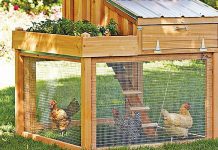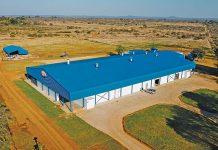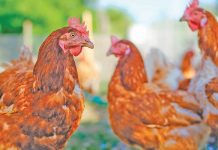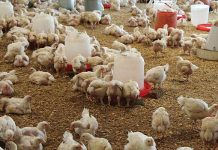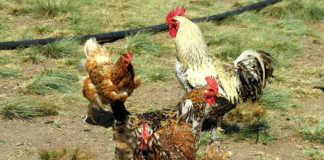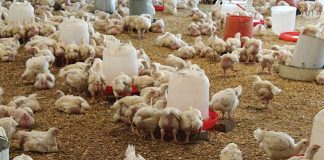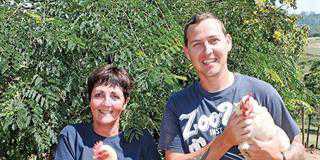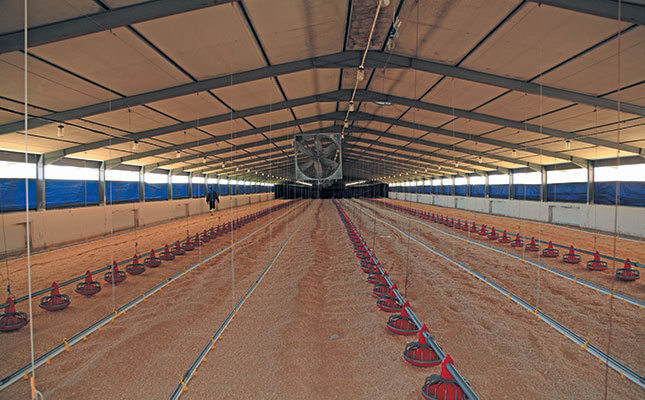
Floor management is one of the pillars of successful broiler production, as important as biosecurity, climate control and general animal welfare. Yet this essential aspect is all too often overlooked.
“Neglect any of these and the business will be at risk,” says Kobus Visser, managing partner of Mabron Broilers on Löttershof Farm near Caledon in the Western Cape. He owns the business with partner Grant Harper. The operation produces broilers on contract for Elgin Free Range Chickens (EFRC) in Grabouw.
Löttershof is not a typical broiler farm. It produces free-range chickens in three 2 025m² houses located 300m to 400m apart.
All EFRC farms are stocked at a far lower density than the norm, at Mabron Broilers the stocking density is about three quarters of the stocking density of controlled houses and at 2 025m², Mabron Broilers’ chicken houses are double the size of those on other farms that supply EFRC. In addition, each bird can range freely outside the houses, with ample access to sunshine, grit and grass.
Yellow maize is the main feed ingredient, being more nutritious and better for broilers than small grain.
Following EFRC standards, the broilers rarely receive antibiotic treatment, and then only when prescribed by a veterinarian. Strict biosecurity measures prevent disease, while the feeding regime includes probiotics and amino acids that promote good gut health.
Litter: a key component
All of this means that litter management is especially important. Indeed, Kobus sees litter as the poultry farmer’s greatest ally – or worst enemy.
“Good floor management improves the living environment,” he explains. “It helps keep birds dry, reduces contact with faecal matter and insulates them from the cold. It improves the environment and reduces stress and vulnerability to disease. The resulting improved feed conversion has a positive impact on growth, which is important in a set-up such as ours that uses no routine antibiotics.”
Good floor management starts with selecting the bedding material. “The ideal material consists of dry friable particles that will stimulate a bird’s natural behaviour to dust-bathe,” says Kobus.
The material should be free of toxins, highly absorbent and quick drying, as wet litter leads to breast blisters, foot burns and ultimately a rejected carcass. Wet litter also emits excessive ammonia, encouraging harmful bacteria and fungi.
“Some material is more susceptible to mould than others,” adds Kobus. Hardwoods and straw, for example, increase the risk of birds developing fungus-related respiratory diseases such as aspergillosis.
The material should not be too coarse, as coarse particles hurt birds’ feet and damage the skin. Large particles also tend to cake, making it difficult to separate again. At the same time, material should not be so fine that it increases the amount of dust in the house, leading to respiratory problems in the birds and workers.
“Certain woods, such as meranti, or material containing bark, tend to be too fine,” notes Kobus.
The material must have good insulation properties to shelter chicks from the cold floor.
The farm has experimented with various materials since broiler production started nine years ago. Chopped straw was found to have particles that were too sharp and tended to cake. The high moisture content of black wattle and eucalyptus shavings made efficient moisture absorption and release a problem.
“I’ve heard of using shredded newspaper, but apparently it also tends to cake, stays wet and lacks good insulation properties,” says Kobus.
Eventually, he settled on pine shavings as most suited to the farm’s conditions, despite considerable variation in the quality of shavings from different suppliers.
“We use only pine shavings from a supplier specialising in poultry bedding,” says Kobus. “The supplier dries the wood before shaving it to prevent fungus problems. The end-product is free of contaminants or objects harmful to the birds. The particle size is also perfect. We no longer have to use underfloor heating!”
Management
Having the correct bedding material means nothing if the operation is not managed properly. Mabron Broilers runs 6,3 cycles of eight weeks each annually. Birds go into the houses as day-olds and come out again at about 36 days.
The remaining two weeks of the cycle are used for maintenance and preparing the houses for the next cycle. A tractor removes old litter the day after the last birds leave.
A fruit grower near Greyton buys the litter and composts it for fertiliser. The house is then cleaned and disinfected. Swab-samples are taken at various points to confirm that the procedure was carried out correctly or to identify possible problems.
An important goal of floor management is to keep litter dry, so the drinking system is checked for leakage before the next batch of chicks arrives in the house. After this, the system is closely monitored and leaks repaired immediately.
“We gradually raise the drinking nipples as chicks grow to ensure a comfortable drinking height and to prevent them from wasting water,” says Kobus.
Bedding material should start off dry. “Seven to 10 days before new chicks arrive, we spread the shavings uniformly over the floor to dry completely,” explains Kobus. “It’s almost impossible to fix problems if you start out with damp material.“
The volume of bedding used is important too: if spread too thinly it cannot absorb as much moisture. The bedding is kept between 7,5cm and 10cm deep – deeper in winter when the moisture level is harder to control and to give the birds extra insulation from the cold.
“In terms of volume of bedding, thicker is better and easier to manage,” says Kobus.
Heat stress in the houses must be prevented as far as possible, as this will see birds drinking and urinating more, with obvious consequence for the moisture content of the bedding.
When fed in excess, certain ration constituents such as salt or high protein grains such as soya can also lead to wet litter. Environmental factors such as wet humid weather or a very low temperature may also cause wet litter problems if the house master cannot eliminate the moisture effectively.
After the chicks have been introduced, the litter is turned manually every day from the fifth day onwards. This helps to keep the material dry and friable.
“Each house has its own house master, who is responsible for the birds through the entire cycle,” explains Kobus.
“The birds become very used to the house master. House masters set their own working hours and receive a bonus when the cycle is completed and they have met their production targets. Only a few other people, responsible for carrying out spot checks, are allowed in the houses.”
When turning the litter, the house master works the fork through the bedding almost like a plough to loosen up caked material. The birds help with this by dust bathing and scratching in the material.
The house masters keep a watchful eye on the behaviour of their charges, spreading their activities evenly throughout the house to prevent wet patches in specific areas.
Because the birds are reared as naturally as possible, gas heating is limited to the first week of production in summer and the first two weeks in winter when a chick is not yet fully feathered and cannot regulate its body temperature. The temperature is maintained at around 30˚C when chicks go into a house and gradually decreased so that it reaches to 19˚C by day 25.
Saving energy
Temperature and humidity levels are measured at different spots in the poultry house to monitor the microclimate. One rule is to never use heating if a door or something else is open. Opening and closing doors, internal and external curtains, pop-holes and extractor turbines/whirlybirds regulates the poultry house microclimate.
The day before new chicks arrive, the house master covers the whirlybird ports with Styrofoam sheets until they need to remove heat and stale air from the house.
The production cycle starts with the chicks occupying only half the broiler house floor space.
“A double row of curtains through the width of the house creates an air pocket and seals off the birds from the unoccupied half, saving energy and preventing heat loss,” says Kobus. “The inner curtains can be removed from day three, depending on weather conditions and the poultry house temperature.”
As the birds are produced free-range, each poultry house has 44 pop-holes, each measuring 2m x 0,6m, allowing the birds exit and entry.
While EFRC free-range standards stipulate that the birds should have access to the outside from day 14 in summer and day 21 in winter, Kobus tries to get them outside as soon as possible.
“This is usually from around day eight, depending on the temperature outside, but we’ve had birds out from even the second day under favourable conditions,” he says. “Going out at an early age is beneficial from a bird welfare perspective. It reduces the load on bedding absorption as the birds spend a large part of their day outdoors, giving the floor a rest.”
Email Kobus Visser at [email protected].



